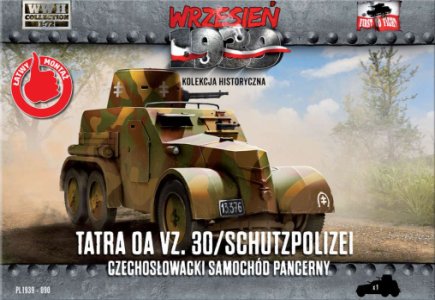|
Brief History & Description
From Wikipedia:
"The OA vz. 30 (full name Obrněný Automobil OA vzor 30, English: Armoured Car Model 30) was a Czechoslovak-designed armored car used by Nazi Germany,
Slovakia, Romania and Hungary during World War II. Fifty-one were built, of which the Germans seized twenty-four when they occupied Bohemia-Moravia in March 1939
and the Slovaks captured eighteen when they declared independence from Czechoslovakia at the same time. Romania acquired nine when Czech troops sought refuge
in Romania after the Hungarian invasion of Carpatho-Ukraine that same month. Slovak vehicles saw combat in the Slovak-Hungarian War, the invasion of Poland,
the opening months of Operation Barbarossa and the Slovak National Uprising."
Crew comprised of a driver, co-driver/machine gunner
and vehicle commander. The 32hp engine drove the rear 4 wheels, and was able to propel the vehicle to a top speed of 60kph on roads. Armament was a pair of
7.92mm ZB vz. 26 machine guns. In German service the type was designated Pz.SpW.30(t).
The Kit
Upon opening the box, its striking how diminutive this vehicle is, being smaller overall, other than height, in comparison with a Willy's Jeep. Packaging is
First to Fight's typical thin, opening from the end style cardboard box. Instructions are two fold - a minuscule exploded diagram on the box's rear panel, plus a
marginally larger version contained in the enclosed Polish only language pamphlet.
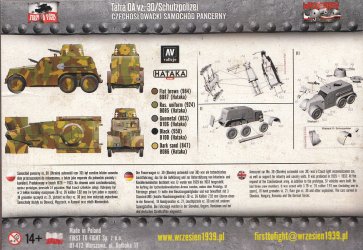 . .
Save your eyes and grab the instructions directly from the First to Fight website or save a copy directly from OTW (click on image below) to make your life easier.
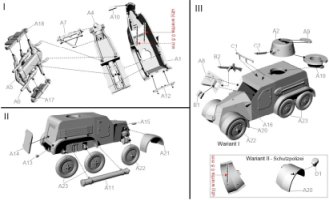
Plastic is the company's usual medium grey styrene that's somewhat soft. Parts count is a modest 31. Pieces are nicely detailed for such a small kit.
Ejector pin marks were only found under the fenders. Some fine grooves, probably from the milling machines producing the moulds, were found on the fenders. A quick
swipe of sandpaper removed them easily.
Seams were few, faint and easily removed. The plastic is easy to mar, so take care with your hobby knife when trimming nubs. Fit is excellent. Decals come on a
very small sheet and provide marking options for 8 vehicles:
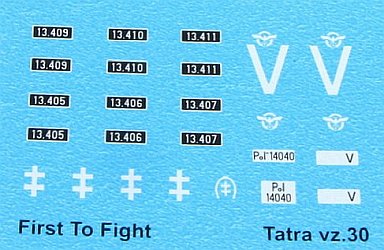
1. Slovak plate numbers 13.405, 13.406, 13.407, 13.409 (ref. [1] pg. 53), 13.410 & 13.411 (ref. [1] pg. 64). All have the three colour camouflage of Dark Sand,
Brown and Medium Green splotches.
The pattern was highly standardized, as seen on pg. 31, 33 & 40 of ref. [1], so it might be best to use the Peewit painting masks listed below to ease the task
of painting such a complicated scheme.
2. German Ordnungspolizei, in overall medium green, plate number Pol 14040.
3. German Ordnungspolizei, in overall medium green, large white V on each side door, and plate numbers only displaying a capital V ([1] pg. 67 showing the
censoring of the plate's numbers).
Of interest is that all of the markings for the vehicle depicted on the box top (13.376) are not included. Turret crosses and the front fender's cross
within a horseshoe are provided, but not the licence plate. How odd! So, if you're buying this kit to build the box top vehicle, you'll be disappointed.
It's also annoying that neither the instructions nor the pamphlet provide guidance regarding decal placement. One is left to refer back to the box top painting,
the colour profiles inside the pamphlet, or even better yet, web photos.
NOTE: Both German vehicle options use optional Notek light (part D1) on the front left fender.
Paint references are for Vallejo and Hataka only.
Let's take a look at the kit's scale. From the table below it looks to be almost spot on.
Dimensions
(reference [1]) | inches
(metres) | 1/72 | Kit Dimensions | Actual Scale |
| Length | 158.27"
(4.02m) | 2.2" | 2.25" | 1/70 |
| Width | 59.84"
(1.52m) | 0.83" | 0.84" | 1/71 |
| Height | 79.52"
(2.02m) | 1.1" | 1.12" | 1/72 |
The Build
I chose to build this as it came in the box. The primary reason is eligibility for the IPMS USA Nationals "Basic Kit Build" category, which doesn't allow for
any materials other than plastic with this build (i.e. no resin, etched, metal or 3D printed parts can be used, even if included in the kit). With that said, there
are a few items to watch for during construction.
1. Plate transfers, for the German vehicles at least, are too large for the moulded on fender brackets. And it looks to me that they have reversed their proper
locations - the large plate on the front right fender and the small plate on the rear right fender.
2. The holes on the rear faces of the wheels are not all exactly the same size nor exactly round. The bad is that, should the modeller assume that they can be
glued in place under the assumption they will all sit on the ground, they will be proved false. The good is that using a slow setting glue, the modeller will be
able to rotate the wheels to get each in place without experiencing any floating wheels.
3. The exhaust system is moulded to the underside. It can be improved by scribing along the pipe edges to provide more relief.
4. The ends of the exhaust pipes should be drilled out.
5. If desired, the headlights could be improved by drilling them out and adding aftermarket lenses.
6. The only places where I employed filler was at the exhaust pipe joint where they meet their counterparts under the body, and to fill the end joints where the rear
valence (part A12) is exposed under the rear fenders.
One item of interest. I was surprised with how smooth the body was, with no hint of weld lines nor rivets. Well, according to reference [1], the body used countersunk
rivets, resulting in a smooth exterior finish.
My build is based on a photo on page 65 in reference [1] showing a vehicle sporting Polizei markings on the turret, no plates and no Notek light on the fender.
So I didn't use the Notek and shaved off the moulded on fender mounted licence plates. I also didn't agree with the suggested mid-green camouflage and went with
German grey instead.
References
[1] Obrněný Automobil OA vz.30: Armoured Car Mo.30, Radomir Zavadil, Jakab Hobby Service, Bučovice 2005, ISBN: 80-903637-1-7
Available Accessories
1. Hauler (resin & etched metal detail set: HLH72136)
2. Peewit (painting mask: M71005)
Additional Notes
First to Fight have another release of the Tatra OA vz.30, kit no. PL1939-095. This version is for a sole German vehicle, probably in Poland, and appears to be based
on this eBay photo: 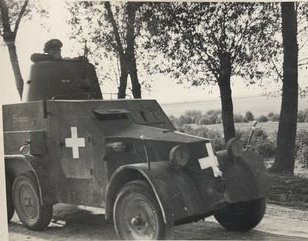
New parts include fender mounted width markers & headlights plus turn indicators on the hull, as well as the relevant decals.
Conclusion
A very nice kit overall. Detail is decent, fit is exemplary and the decals are well printed and set down well with decal solvent such as Microsol. The only let down
is the poor instructions and lack of decal placement information. Otherwise, it makes
for a pleasant and uncomplicated build.
Review sample purchased by the author.
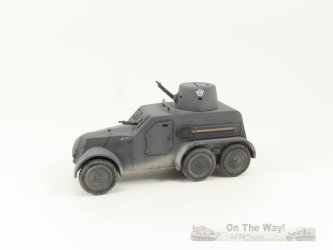
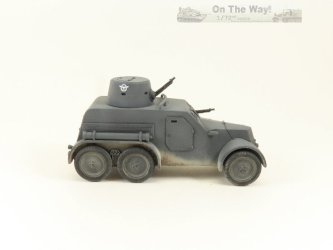
|
